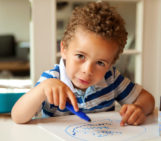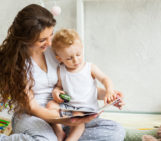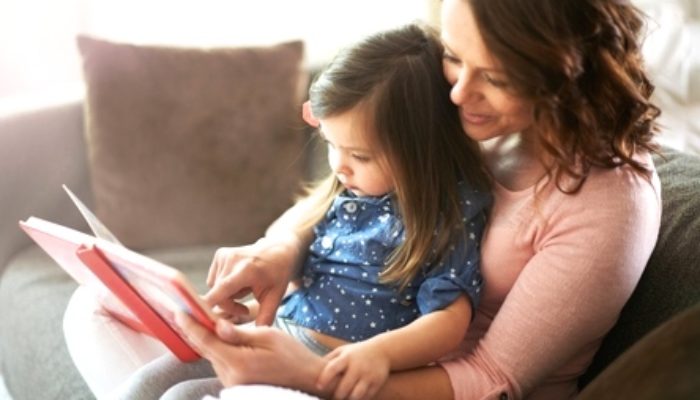
You have probably read some of those little “pointing” books with your baby. You know, those books with hard pages and a single object pictured on each page. You point to the picture and name the object. Pretty soon, your baby points to each picture as you turn the page and might even try to imitate the word. This is a great way to stimulate your child’s early speech development and teach some basic naming words. But how much is your child really learning from that single activity? What is really involved in learning words?
What is a Word?
In and of itself, a word is nothing more than a sequence of sounds, or “phonemes,” spoken by someone. This sound sequence becomes a true word only as we assign meaning to it. Corresponding words in different languages or even dialects may have slightly different meanings or connotations. All of us have had occasion to smile at the comical effect of a foreigner using an English word incorrectly, or a young child using a word he or she only vaguely understands.
Learning to Say Words
To learn a new word, the child needs to master two separate skills. On the one hand, the child needs to be able to imitate the sound sequence that makes up the word and later recall and repeat it without first hearing it again. To accomplish this, he or she will need to hear it many times, often before even attempting to say it. (See further Learning the Speech Sounds) Being able to say the word and recall the word is not enough, however.
Learning to Understand and Use Words
The child also needs to gain an understanding of the word’s meaning. This is usually a gradual process. The child must hear the word in a variety of situations and must then have opportunity to experiment with its use.
Learning word meanings involves the mental processes of classifying, comparing, and contrasting. Initially, young children tend to over-specify or over-generalize the meanings of words. The word “chair” might, in the child’s mind, refer only to his or her high chair. The word “blanket” might only mean the child‘s own, favorite blanket. But, “car” might refer to anything on wheels and “wawa” might mean any drink. Mom may feel somewhat insulted by the fact that “mama” is used to refer to any woman.
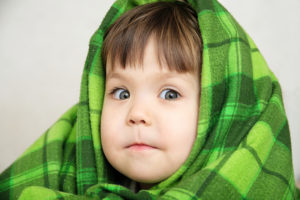
Three Groups of Words
I like to group words into three types based on their functions:
- Content Words. These are the words, which carry the main meaning of a sentence. They include naming words (nouns), action words (main verbs), and describing words (adjectives and some adverbs).
- Structure Words. These are the words that do not add new meaning to the content of the sentence. They are mainly used to show relationships between the content words and to build sentence structure. Words that refer to content already introduced or not known such as most pronouns can also be considered structure words. Structure words are the “little words,” such as auxiliary verbs (is, are, will etc.), prepositions (on, in, from etc.), articles (a, an, the), conjunctions (and, if, because etc.), pronouns, and many adverbs.
- Signal words. This third group consists of words, which are not used as part of a sentence. They are used by themselves to signal an emotion, need, or desire, or simply to call attention. In the adult language, they include greetings and interjections like “Hey!” “Wow” etc. They also include proper names when used to call someone rather than to talk about someone. Certain short phrases may also be considered signal “words,” even though in reality they consist of more than one word. These are phrases that are usually said a standard way, “Thank you,” “Good morning.”
Your Child’s First Words
Signal words
The child’s first words are generally used as signal words. The word “mama” may initially simply signal “l want to be held” rather than refer to the child’s mother. The word “down” may not have taken on its lexical meaning of downward motion, but may mean, “I have had enough of this food, and want you to get me down from my chair.” “Uh-oh” and “Bye-bye” are common signal words, which often appear very early.
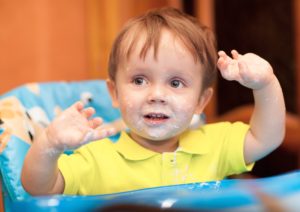
Content words
A few naming words are likely to appear among the child’s first ten words. They might be family members’ names, favorite foods or toys, basic body parts etc. The child’s version of the word “water” may initially be a signal word, indicating “I am thirsty and want a drink.” It becomes a naming word, when it is used to specifically mean water as opposed to other drinks.
A few describing words, such as “pretty,” “hot” and “big” are likely to appear among the child’s first 20-30 words. Be aware that young children do not generally learn these early describing words as opposites. For example, they tend to learn “big” long before they learn “small” or “little.” They may learn the word “tiny” but not relate it to “big” as its opposite. Instead, they simply associate these words with specific items or situations in which they have been used.
A few action words may appear in signal word phrases such as “go bye bye,” but at that point, these words have not yet taken on their specific, lexical meaning. True action verbs may not appear in the child’s vocabulary until the time when he or she is starting to combine words into sentences, normally around the age of two years.
By the time the child is using 20 or more words, the proportion of content words to signal words can give us an idea of the quality of the child‘s vocabulary.
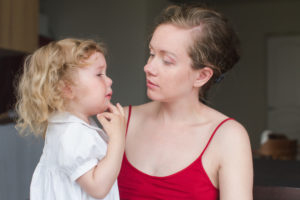
Structure Words
Structure words do not generally become part of the child’s vocabulary before the child is approaching three years of age. Even then, the child is most likely not aware of these words. They are simply incorporated into sentence structures the child has learned. True awareness of how or why these words are used might not develop until the child is learning to read. Exceptions would be some common pronouns, but at this early stage the child is likely to use them incorrectly in an overgeneralized way. Most young children refer to themselves as “me” as in the sentence, “Me do it!” Some children will use the short and easy to say pronoun “he” in place of both “she” and “they.”
My child used to say words, which he is no longer using. Is he regressing?
It is disconcerting to parents, when a child seems to drop words from his vocabulary. You naturally wonder if something happened to make your child regress. There are events that could cause regression (see my article Is My Child Regressing?). It is, however, common in the early stages of a child’s speech development that newly learned words are dropped.
The child may only be able to handle a limited number of words. As the child learns new words, some old ones may be dropped in favor of the new ones. Thus, although the child’s speaking vocabulary is not noticeably increasing, neither is it significantly decreasing. It could be said that a plateau is reached with regard to vocabulary size while the child is experimenting with different words.
With proper stimulation, the vocabulary development will start to take off. You will then see that your child more rapidly adds new words including those that were previously dropped. If this does not happen and your child remains at a plateau for several months, this may be an early sign that the child has significant word retrieval difficulties. It would then be wise to consult a professional speech-language pathologist or early intervention program.

